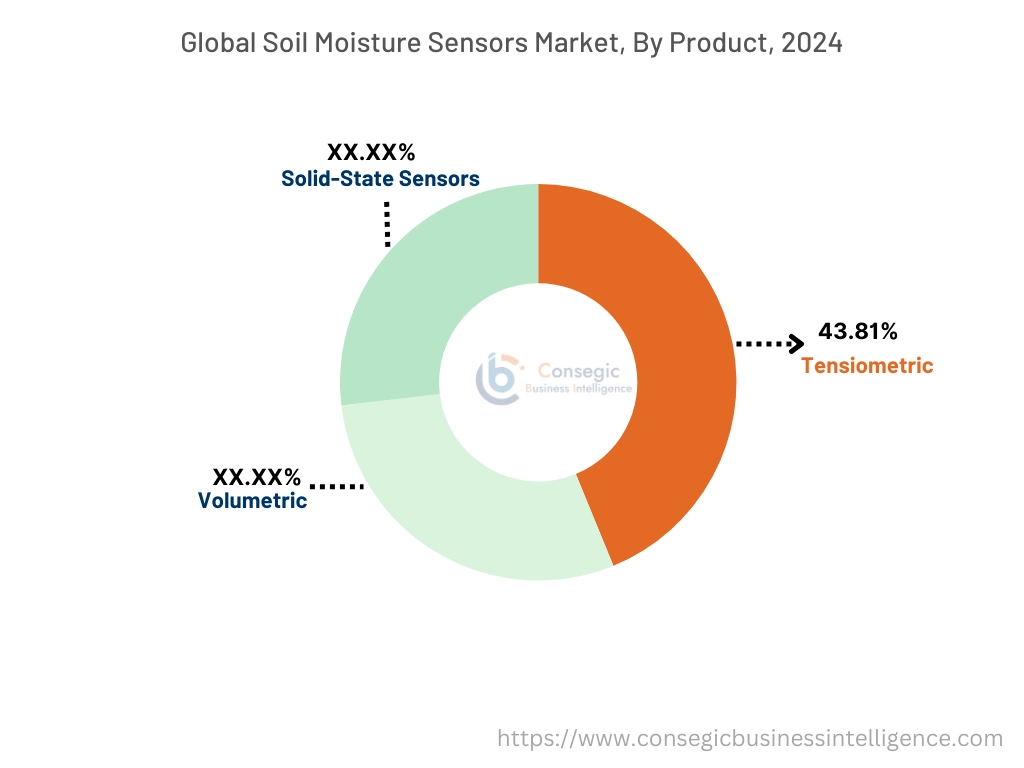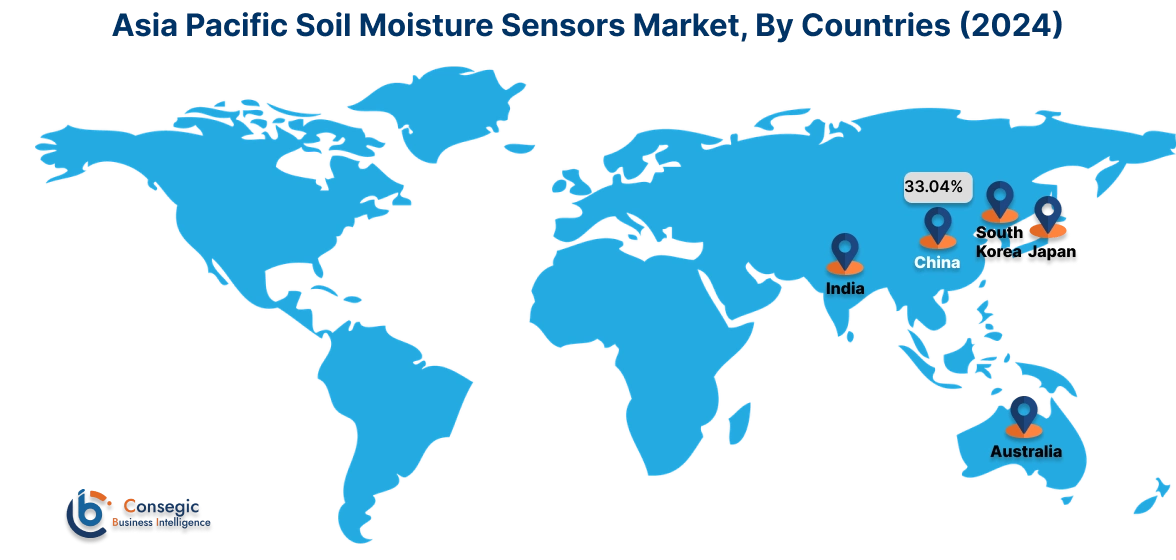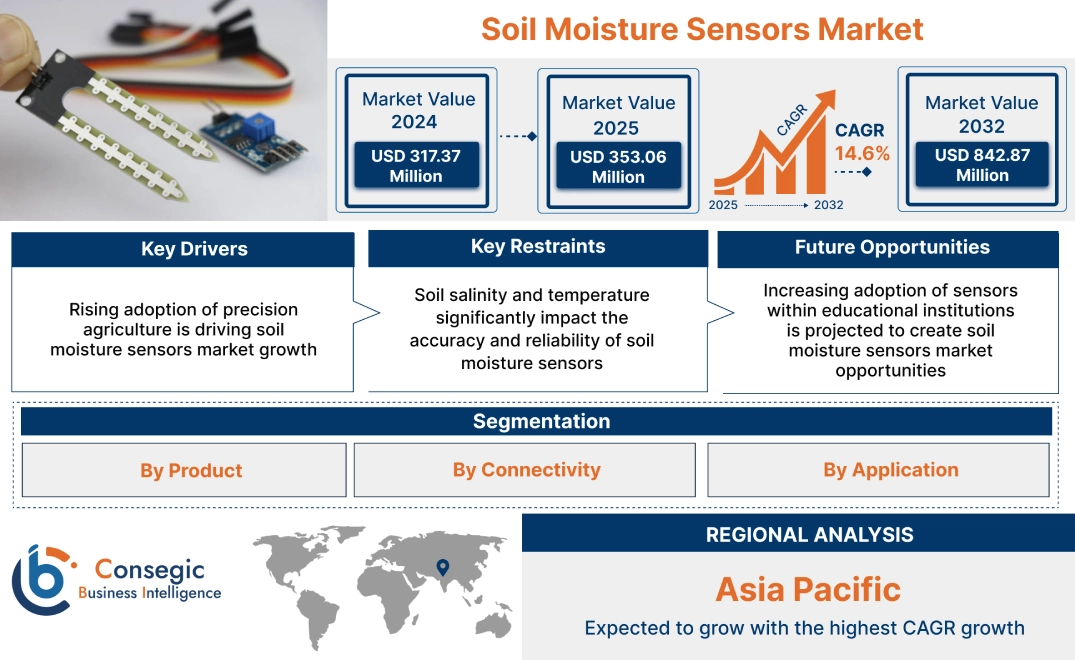- Summary
- Table Of Content
- Methodology
Soil Moisture Sensors Market Size:
Soil Moisture Sensors Market Size is estimated to reach over USD 842.87 Million by 2032 from a value of USD 317.37 Million in 2024 and is projected to grow by USD 353.06 Million in 2025, growing at a CAGR of 14.6% from 2025 to 2032.
Soil Moisture Sensors Market Scope & Overview:
Soil moisture sensors are devices designed to measure the volumetric water content within soil. The sensors work by detecting the dielectric constant of the soil, which varies depending on the amount of water present. They translate this measurement into an electrical signal that can be read and interpreted, providing valuable data for applications in agriculture, environmental monitoring, and irrigation management.
Key Drivers:
Rising adoption of precision agriculture is driving soil moisture sensors market growth
Soil moisture sensors provide farmers with real-time soil water information, allowing for precise irrigation that minimizes water use and increases crop yields. By providing accurate soil moisture data, the sensors help farmers use resources like water and fertilizers more efficiently, which reduces environmental impact and also improves the economic viability of farming operations. Further, optimal soil moisture levels are crucial for healthy plant growth and sensors help to maintain these levels, leading to increased crop yields and improved crop quality. Additionally, these sensors are integrated with smart farming technologies, such as GPS, drones, and automated irrigation systems, which enhances the efficiency of agricultural operations, hence boosting the soil moisture sensors market size.
- For instance, in Nov 2024, CropX announced to introduce a new sensor to the Australasia region that measures real-time plant water use through evapotranspiration (ET). This above-canopy sensor integrates with CropX's farm management system, providing farmers with precise data on crop water needs. Also, this technology enables data-driven irrigation scheduling and remote management, aiming to significantly improve water efficiency in agriculture.
Consequently, the rising adoption of precision agriculture is driving the soil moisture sensors market expansion.
Key Restraints:
Soil salinity and temperature significantly impact the accuracy and reliability of soil moisture sensors
Soil salinity alters the electrical conductivity of the soil, leading to inaccurate readings, as the sensor may misinterpret the increased conductivity as higher moisture content. This is particularly problematic in arid and semi-arid regions where soil salinity is prevalent, limiting the effectiveness of these sensors in those crucial agricultural areas. Additionally, temperature variations significantly alter soil's dielectric properties, creating inconsistencies in soil moisture sensor readings. This poses a major restraint, especially in environments with extreme temperature swings, where precise data is crucial for effective irrigation, further restraining the growth of the global soil moisture sensors market.
Therefore, as per the analysis, these combined factors are significantly hindering soil moisture sensors market expansion.
Future Opportunities :
Educational institutions are incorporating soil moisture sensors into their curricula to provide students with hands-on experience in environmental science, agriculture, and engineering. This practical learning approach increases need for these sensors, as schools and universities invest in equipment for their labs and field studies. Additionally, universities and research institutions utilize soil moisture sensors for in-depth studies on soil science, hydrology, and climate change. The research drives innovation and the development of more advanced and specialized soil moisture sensor technologies, thus boosting the soil moisture sensors market demand.
- For instance, in Jan 2025, Vernier Science Education introduced the Go Direct Soil Moisture Sensor, a wireless sensor designed for high school and college students. The sensor facilitates practical, hands-on learning in various science disciplines by enabling students to easily and accurately measure soil volumetric water content. Connected directly to student devices via the Vernier Graphical Analysis Pro app, the sensor aims to enhance engagement in investigations related to soil science, agriculture, environmental studies, horticulture, botany, and biology.
Hence, based on the analysis, increasing adoption of sensors within educational institutions is expected to create soil moisture sensors market opportunities.
Soil Moisture Sensors Market Segmental Analysis :
By Product:
Based on the Product, the market is trifurcated into Tensiometric, Volumetric, and Solid-state Sensors.
Trends in the Product:
- Solid-state sensors utilize capacitance or frequency domain reflectometry (FDR), are gaining traction due to their compact size and low power consumption.
- Growing trend towards the adoption of tensiometric sensors in landscaping and environmental monitoring to accurately measure soil water tension.
Tensiometric accounted for the largest revenue of 43.81% in 2024.
- Advancements in tensiometer technology are significantly improving their accuracy and reliability, crucial for applications requiring precise measurements of soil water tension.
- Tensiometers provide precise measurements of soil water tension, a crucial factor in plant water availability, becoming a valuable tool in agriculture, landscaping, and environmental studies.
- Additionally, the rising awareness of the importance of effective soil moisture management across various sectors is driving demand for tensiometers to provide valuable data for optimizing irrigation and water use.
- In addition, the development of UV-resistant construction and IP68-rated watertight seals is also driving the market share.
- For instance, Labcell Limited offers the TEROS 32 Tensiometer in its product portfolio, a precision instrument designed for reliable outdoor soil moisture measurement. This tensiometer offers direct pore pressure readings without requiring calibration and handles both positive and negative pressures. Key features include an integrated temperature sensor, durable UV-resistant construction, IP68-rated watertight seals, and a robust design for year-round operation.
- Thus, as per the soil moisture sensors market analysis, the aforementioned factors are driving the tensiometric sensors segment growth.
Volumetric Sensors is predicted to register the fastest CAGR during the forecast period.
- Increasing adoption of precision agriculture is expected to drive the demand for volumetric sensors to optimize irrigation, leading to improved crop yields and efficient water usage.
- Continuous improvements in sensor technology, particularly in dielectric sensors, heat dissipation sensors, and neutron moisture probes, are enhancing accuracy and reliability.
- The integration of volumetric sensors with IoT platforms and data analytics tools is enabling real-time data monitoring, crucial for optimizing resource management.
- Volumetric sensors are extending their reach beyond agriculture, finding valuable applications in landscaping, environmental monitoring, construction, and mining.
- Consequently, the aforementioned factors are driving the growth of volumetric sensors segment.

By Connectivity:
Based on the Product, the market is trifurcated into Tensiometric, Volumetric, and Solid-state Sensors.
Trends in the Product:
- Solid-state sensors utilize capacitance or frequency domain reflectometry (FDR), are gaining traction due to their compact size and low power consumption.
- Growing trend towards the adoption of tensiometric sensors in landscaping and environmental monitoring to accurately measure soil water tension.
Tensiometric accounted for the largest revenue of 43.81% in 2024.
- Advancements in tensiometer technology are significantly improving their accuracy and reliability, crucial for applications requiring precise measurements of soil water tension.
- Tensiometers provide precise measurements of soil water tension, a crucial factor in plant water availability, becoming a valuable tool in agriculture, landscaping, and environmental studies.
- Additionally, the rising awareness of the importance of effective soil moisture management across various sectors is driving demand for tensiometers to provide valuable data for optimizing irrigation and water use.
- In addition, the development of UV-resistant construction and IP68-rated watertight seals is also driving the market share.
- For instance, Labcell Limited offers the TEROS 32 Tensiometer in its product portfolio, a precision instrument designed for reliable outdoor soil moisture measurement. This tensiometer offers direct pore pressure readings without requiring calibration and handles both positive and negative pressures. Key features include an integrated temperature sensor, durable UV-resistant construction, IP68-rated watertight seals, and a robust design for year-round operation.
- Thus, as per the soil moisture sensors market analysis, the aforementioned factors are driving the tensiometric sensors segment growth.
Volumetric Sensors is predicted to register the fastest CAGR during the forecast period.
- Increasing adoption of precision agriculture is expected to drive the demand for volumetric sensors to optimize irrigation, leading to improved crop yields and efficient water usage.
- Continuous improvements in sensor technology, particularly in dielectric sensors, heat dissipation sensors, and neutron moisture probes, are enhancing accuracy and reliability.
- The integration of volumetric sensors with IoT platforms and data analytics tools is enabling real-time data monitoring, crucial for optimizing resource management.
- Volumetric sensors are extending their reach beyond agriculture, finding valuable applications in landscaping, environmental monitoring, construction, and mining.
- Consequently, the aforementioned factors are driving the growth of volumetric sensors segment.
By Connectivity:
Based on the Connectivity, the market is categorized into Wired and Wireless.
Trends in Connectivity:
- Wired sensors are suitable in large-scale agricultural operations and research facilities where continuous data transmission is critical.
- Increasing adoption of IoT technologies and the demand for remote monitoring capabilities is driving the wireless sensors trend.
Wireless accounted for the largest revenue share in 2024 and is also projected to register the fastest growth.
- Wireless sensors eliminate the constraints of physical wiring, enabling easier and more flexible deployment uneven terrains, particularly advantageous in large-scale agricultural operations.
- Wireless sensors minimize installation costs by eliminating the need for extensive trenching and cable laying, thus driving soil moisture sensors market demand.
- Wireless sensor networks can be easily scaled up or down to accommodate changing monitoring needs, further contributing to the soil mosture sensors market growth.
- For instance, in August 2020, Onset has launched the HOBOnet Multi-Depth Soil Moisture Sensor, a wireless device designed for efficient, large-scale remote soil monitoring. This sensor, compatible with Onset's HOBOnet mesh network, measures soil moisture and temperature at multiple depths using a single probe, simplifying installation.
- Therefore, as per the market analysis, the aforementioned benefits are bolstering the soil moisture sensors market trend.
By Application:
Based on the Application, the market is divided into Agriculture, Forestry, Sports, Weather Forecasting, Research Studies, Landscaping and Ground Care, and Others.
Trends in the Application:
- Growing trend towards the adoption of soil moisture sensors to monitor forest health, assess wildfire risk, and optimize reforestation efforts.
- Soil moisture sensors are being used to maintain optimal turf conditions on sports fields, ensuring player safety and field quality.
Agriculture accounted for the largest revenue share in 2024 and is also predicted to register the fastest growth.
- Leading trend driving the soil moisture sensor market is precision agriculture, as farmers prioritize optimizing irrigation, minimizing water waste, and maximizing crop production, hence driving the market demand.
- Integration with IoT platforms and data analytics is becoming standard practice, enabling real-time monitoring and automated irrigation systems.
- Generally, there is increased need for sensors that can provide data at multiple depths, to give a more complete picture of the soil, thereby boosting the soil moisture sensors market size.
- Consequently, the expanding agricultural sector is contributing significantly in driving the soil moisture sensors market share.
- For instance, the Indian agriculture sector has shown strong increase, averaging 5% annually from FY17 to FY23, and 3.5% in the second quarter of FY25, despite facing various challenges. Notably, the sector's Gross Value Added (GVA) contribution has significantly increased, rising from 24.38% in FY15 to 30.23% in FY23, indicating its growing importance to the national economy.
- Thus, as per the analysis, the aforementioned factors are driving the soil moisture sensors market share.
Regional Analysis:
The regions covered are North America, Europe, Asia Pacific, the Middle East and Africa, and Latin America.

Asia Pacific region was valued at USD 80.04 Million in 2024. Moreover, it is projected to grow by USD 89.30 Million in 2025 and reach over USD 220.07 Million by 2032. Out of these, China accounted for the largest revenue share of 33.04% in 2024. The region's large population and increasing need for food necessitate higher agricultural productivity. Additionally, rapid infrastructure development across the region is also contributing to the demand for these sensors in construction and other sectors. Moreover, the rise of smart agriculture, incorporating IoT and data analytics, is boosting sensor adoption and countries like Australia, Japan, India, and China are at the forefront of this trend.
- For instance, in 2022, China's agriculture and related industries contributed significantly to the national economy, with an added value of 19,569.2 billion yuan. This sector accounted for 16.24% of China's total GDP, marking a slight increase of 0.19 percentage points from the previous year, indicating a continued, if marginally increasing, importance of agriculture to the Chinese economy.

North America was valued at USD 119.11 Million in 2024. Moreover, it is projected to grow by USD 132.43 Million in 2025 and reach over USD 314.14 Million by 2032. Increasing awareness of water scarcity and the need for sustainable practices is pushing farmers and manufacturers to invest in soil moisture sensors to minimize water waste. Additionally, government programs promoting sustainable farming and water conservation further stimulate the need for soil moisture sensors.
- For instance, in August 2024, Sustainable Conservation and Netafim USA have received a grant from the NRCS to pilot a new irrigation system at De Jager Dairy. This project will adapt their successful dairy effluent subsurface drip irrigation system for almond orchards, aiming to improve water and nutrient management in almond farming.
As per the soil moisture sensors market analysis, Europe's strong focus on environmental sustainability and stringent regulations regarding water usage are driving the adoption of soil moisture sensors. Additionally, the Common Agricultural Policy (CAP) and other initiatives promote efficient resource management, encouraging farmers to adopt precision agriculture techniques. Latin America has a significant agricultural sector, with a growing emphasis on increasing productivity and efficiency. The ME&A region faces severe water scarcity, making efficient irrigation a critical priority. Governments are investing in water management technologies to ensure food security.
Top Key Players and Market Share Insights:
The market is highly competitive with major players providing soil moisture sensors to the national and international markets. Key players are adopting several strategies in research and development (R&D), product innovation, and end-user launches to hold a strong position in the market. Key players in the soil moisture sensors industry include-
- Acclima Inc. (United States)
- Campbell Scientific Inc. (United States)
- Delta-T Devices Ltd. (United Kingdom)
- S.I. Environmental Sensors Inc. (Canada)
- IMKO Micromodultechnik GmbH (Germany)
- Irrometer Company, Inc. (United States)
- METER Group, Inc. (United States)
- OTT Hydromet GmbH (Germany)
- ABB (Switzerland)
- iRobot (US)
- KUKA (Germany)
- FANUC (Japan)
- Hanson Robotics (China)
Recent Industry Developments :
- In September 2022, Murata launched a new soil sensor designed to enhance sustainable agriculture. This sensor provides simultaneous measurements of soil electrical conductivity (EC), water content, and temperature, offering farmers crucial data for optimizing crop development.
- In April 2022, Sensoterra released its next-generation Single Depth soil moisture sensor featuring significant improvements. The sensor now boasts a 2-4x increase in LoRaWAN signal strength, achieved through a new antenna design, ensuring reliable data transmission even in difficult environments.
Soil Moisture Sensors Market Report Insights :
| Report Attributes | Report Details |
| Study Timeline | 2019-2032 |
| Market Size in 2032 | USD 842.87 Million |
| CAGR (2025-2032) | 14.6% |
| By Product |
|
| By Connectivity |
|
| By Application |
|
| By Region |
|
| Key Players |
|
| North America | U.S. Canada Mexico |
| Europe | U.K. Germany France Spain Italy Russia Benelux Rest of Europe |
| APAC | China South Korea Japan India Australia ASEAN Rest of Asia-Pacific |
| Middle East and Africa | GCC Turkey South Africa Rest of MEA |
| LATAM | Brazil Argentina Chile Rest of LATAM |
| Report Coverage |
|
Key Questions Answered in the Report
How big is the Soil Moisture Sensors market? +
The soil moisture sensors market size is estimated to reach over USD 842.87 Million by 2032 from a value of USD 317.37 Million in 2024 and is projected to grow by USD 353.06 Million in 2025, growing at a CAGR of 14.6% from 2025 to 2032.
What specific segmentation details are covered in the soil moisture sensors report? +
The soil moisture sensors report includes specific segmentation details for product, connectivity, application, and regions.
Which is the fastest segment anticipated to impact the market growth? +
In the soil moisture sensors market, wireless is the fastest-growing segment during the forecast period.
Who are the major players in the Soil Moisture Sensors market? +
The key participants in the Soil Moisture Sensors market are Acclima Inc. (United States), Campbell Scientific Inc. (United States), Delta-T Devices Ltd. (United Kingdom), E.S.I. Environmental Sensors Inc. (Canada), IMKO Micromodultechnik GmbH (Germany), Irrometer Company, Inc. (United States), METER Group, Inc. (United States), OTT Hydromet GmbH (Germany), SDEC France (France), Sentek (Australia), Spectrum Technologies, Inc. (United States), Stevens Water Monitoring Systems Inc. (United States), Toro Company (United States), Vegetronix, Inc. (United States), and Others.


